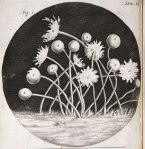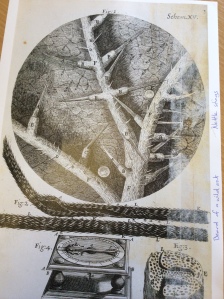Micrographia workshop in Exeter Cathedral Library
I don’t often get the chance to attend someone else’s workshop, but when I saw this one advertised I jumped in fast. What a treat to be given the opportunity to learn more about science and the natural world, and to hear, write and share poetry.
The workshop took place this morning at Exeter Cathedral Library, where we started by looking at and learning about Robert Hooke’s ‘Micrographia’ of 1665, and playing with lots of microscopes, before settling down to write some poetry. There was room for only ten people, so I was glad I booked early.
Robert Hooke was an amazing polymath: natural philosopher, botanist, inventor, architect, astronomer and much more. We owe him (among other things) Hooke’s Law and the term ‘cell’ for describing biological organisms.
 But today our interest in him was predominantly for his magnum opus, ‘Micrographia’, which was on display for us to inspect and handle.
But today our interest in him was predominantly for his magnum opus, ‘Micrographia’, which was on display for us to inspect and handle.

Felicity Henderson of Exeter University co-ordinated the event; and Mark Ramsdale and Katie Solomon from the university’s Biosciences Department kindly brought along a dozen or so microscopes of different ages and magnifications for our use. These ranged from a replica of Hooke’s original instrument (the actual one being in an American library) to very modern all-singing-all-dancing models.
We also had access to scores of tiny 19th century glass plates, all labelled in copperplate writing. Inside these plates were imprisoned the plant, animal and insect specimens that we then studied under the microscopes, delighting in our access to such a miniature fairy-tale world.
There were plenty of ticks, fleas, lice and other such delights; but my four favourite slides were the following:
A humming bird’s feathers illuminated in vibrant colours of puce, lime and purple;
Dragonfly wings which under the microscope were revealed to be made up of fine tracery, with tiny ‘stained glass windows’ at the edges;
Mould, which when magnified many times looked for all the world like a pleasant summer garden
 and (perhaps best of all)
and (perhaps best of all)
nettle stings with their fine hairs and mini syringes to pump poison into our skin.
The ropes across the page below the nettle leaf in this slide are the beards of a wild oat.
Having subjected a full stop to his microscopic investigation, Hooke described what he saw as ‘like a great splotch of London dirt’. I think that image will stay with me for a while, and add interest to the normal procedures of punctuation.
The second part of the morning was given over to a couple of writing exercises, introduced by the poet Matthew Francis. The first exercise he gave us was to experiment with syllabic poetry, and he set us the pattern of syllables <13, 10, 7, 6, 5, 4>, which is a pattern he has used successfully for all the poems in his recent collection, ‘Whereabouts’. The other exercise used some extracts from Micrographia to inspire our own work.
It is always a joy to hear what other poets come up with in response to prompts and challenges, and although I didn’t feel that my first effort at syllabic poetry was particularly impressive, it has inspired me to experiment a little with this form. It was interesting that when Matthew joined us in writing to the prompt, the poem he came up with was far more balanced and polished – which rather suggests that once one gets accustomed to the form, it can flow as easily as any other style of writing.


Yes, everything is beautiful from the right perspective. You have to get really really close to mould to appreciate it fully!! xx
That was quick! And I love the thought that everything (and everyone?) is beautiful from the right perspective. Thanks.
Sounds like a wonderful workshop Alwyn, luck you! It’s the science that keeps my residency so bright! xx c
[…] In the morning Matthew Francis led the writers in a couple of exercises, the first using syllabic verse, the second responding to a section of Hooke’s text. This Micrographia extract (on the ‘small, Silver-colour’d Book-worm’, or silver-fish), when re-lineated and truncated, appeared to be a poem in its own right, such is the richness of Hooke’s language and imagery. I was interested to see the range of responses from the writers, some choosing to focus on the things they had observed through microscopes, others reflecting on the act of seeing, or the contrast between human and microscopic scale. (Poet Alwyn Marriage has blogged about her experience here.) […]
What a fascinating workshop. I love these sessions which in some way or another fuse science and literature. And you wrote about it beautifully as always. Hope all’s well with you and that we get to see you at some point. Everything’s a bit hectic here at the moment but sooner or later we’ll get together, yes? Love to you both Angela x
Thanks Angela. I think you would have enjoyed it. And yes, it would be good to meet up as soon as we return from our grandparental duties.